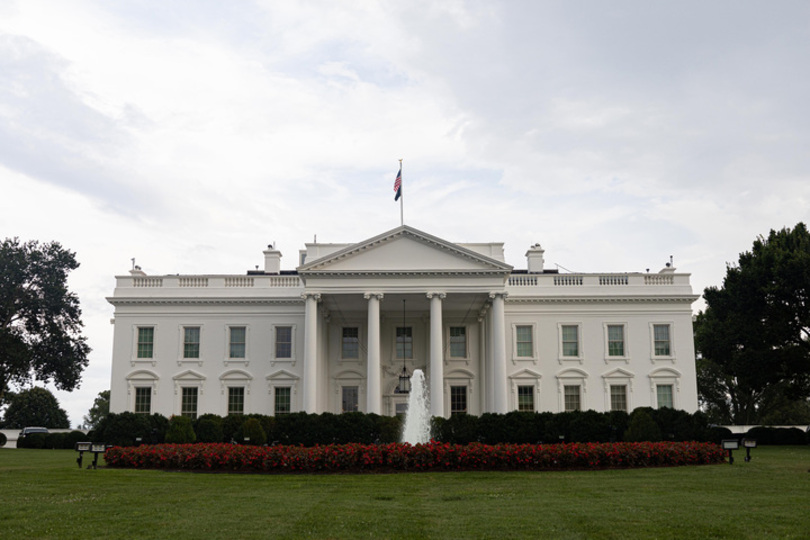Opinion: White House theater demolition symbolizes abandonment of 3rd spaces

Our columnist warns of the danger of replacing local engagement with digital communities. It’s important to intentionally step away from the illusion of community presented by social media and toward true third spaces, they argue. Cassandra Roshu | Senior Staff Photographer
Get the latest Syracuse news delivered right to your inbox.
Subscribe to our newsletter here.
When President Donald Trump commenced demolition of the White House’s East Wing Saturday, its family theater was sent tumbling down with it. Once a collective space for the first family and invitees, the theater’s rich reds and lustrous golds now rest in rubble. And with it, we see a symbol for the national loss of recreational spaces.
The theater’s demolition is reflective of a broader American trend: the loss of third places, or public spaces where people can informally congregate. Post-pandemic closures have seen the loss of over 5,000 theater screens nationwide, and threats to sell public land are becoming increasingly common.
But theaters are only one example. Suburban America once hosted manicured parks, movie theaters and community centers where residents could laugh with friends after a movie, talk over a picnic spread or play recreational sports.
Popular television of the ‘90s and 2000s boasted third places as a hub for meet-cutes like Luke’s diner in “Gilmore Girls” or the starting point for close friendships like Central Park in “Friends.” The romanticization of happenstance meetings and tightly knit communities facilitated by third spaces is a charm that’s been lost to the digital age.
Fantasies about a community-centered life are an essential and universal element of the American dream, yet their reality continues to drift farther and farther away. Places that once bustled with life are now silent, and people more frequently opt for a homebody way of life.
Third spaces aren’t the only ones taking a hit – remote work has skyrocketed in popularity since the COVID-19 pandemic, causing the decline of second spaces as well. Digitalization has wrked its way into nearly every facet of life, and as society has grown accustomed to a lifestyle of isolation, collective spaces are taking the hit.
The result is a cycle of reclusion. Of course, closing ourselves off has led to the slow elimination of third places, but the reverse is true as well. The elimination of third places has equally hastened the process of turning inwards.
“Back in my day” stories of antics in the park and lively town squares are hard to imagine in the modern day. The third place has shifted – “iPad kids” and TikTok-addicted teenagers are not so by choice, but rather because socialization has shifted in that direction. Following the COVID-19 pandemic, there was an estimated 70% increase in social media use, which was used to fulfill people’s social and emotional needs.
Third places are meant to be spaces where people can gather, form identity and build community. When social media replaces them, these fundamental needs are not met.
Today’s youth fall victim to the illusion of community presented by social media. While social media fuels the façade of connection through likes, comments and other online interactions, they are often short-lived and superficial. Social needs get met through gaming with anonymous users online, or participating in discussions under Instagram posts, limiting real-life interaction.
In-person social interaction has a greater capacity to create lasting bonds. Third spaces have the potential to forge shared experiences more genuinely – connections that can’t be made through the mere click of a button. The effort of continually meeting up and slowly harvesting a relationship allows for more solid foundations to be built, and cultivates integral social skills.
For instance, real community spaces force social etiquette. The online protection of anonymity allows people to adopt more abrasive language, harass others and be more hostile. Adopting this habit online can easily translate to in-person interactions later on in life, especially when formative socialization is done in digital spaces.
The other extreme is when community-building online becomes a performance. It’s not a secret that social media is a place to share a personal “highlight reel.” Instead of connecting with someone’s true character, you’re developing a relationship with a highly curated and overly polished version of them.
While it is possible to create genuine connections on social media, the likelihood of authentically enjoying a person’s company is far greater when they’re unable to overly self-filter.
Third spaces have the potential to forge shared experiences more genuinely – connections that can’t be made through the mere click of a button.Varsha Sripadham, Columnist
Although social media allows us to transcend location-related limits and interact with a broader array of people, it shouldn’t come at the cost of interaction with local communities and shared spaces.
Strong communities can look out for each other in times of local distress, and are directly linked to greater civic engagement. Local connections have the potential to cause a positive impact down the line, as someone next door can better address immediate needs than a digital friend who lives far away.
We must re-learn to intentionally step away from phones and towards true third spaces. Libraries, cafés, recreation centers and other community spaces attract a wealth of people bridging different life experiences, generations and demographics.
While it is easy to get swept up in strong opinions and heated debates online, face-to-face engagement forces the humanization of opposing views and encourages compromise.
We should be skeptical of replacing local engagement with digital communities, especially when local resources have so much to offer. Supporting local coffee shops, appreciating libraries or opting to watch a movie in theaters are all ways to prevent the death of third places. Keeping the option of accessible community interaction open for future generations helps promote a more socially aware and responsible society.
Varsha Sripadham is a freshman majoring in journalism and law, society and policy. She can be reached at vsripadh@syr.edu.





